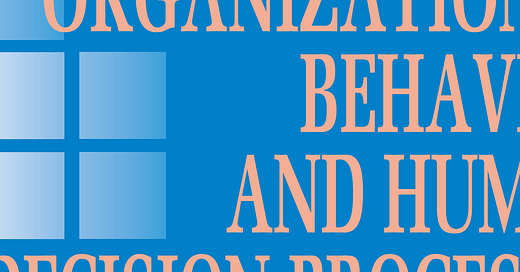New articles in OBHDP (May 15th, 2024)
Different ally motivations lead to different outcomes: How self-transcendence and self-enhancement values predict effectiveness of self-identified allies
https://www.sciencedirect.com/science/article/abs/pii/S0749597824000256
L. Taylor Phillips, Tamar A. Kreps, Dolly Chugh
The authors question whether people’s reasons for identifying themselves as allies might relate to their effectiveness as allies. Across three experiments, the authors explore two values that might underlie allyship: self-transcendence (enhancing the welfare of others) and self-enhancement (pursuing personal status and esteem). They found that although both values can generate ally engagement, self-transcendence tended to promote greater ally effectiveness. Whereas self-transcendence and, less consistently, self-enhancement predicted increased activism intentions, only self-transcendence predicted behavior. Their research also found that ally values impacted audience reactions: ally self-transcendence was associated with greater persuasiveness, while self-enhancement was associated with lower persuasiveness. Taken together, their results suggest that self-transcending allies may be more likely to follow through on their intentions to help the cause, and they may be more effective at persuading others to support the cause.
Not all allies are created equal: An intersectional examination of relational allyship for women of color at work
https://www.sciencedirect.com/science/article/pii/S0749597824000232
Barnini Bhattacharyya, Samantha E. Erskine, Courtney McCluney
Allyship is typically considered a positive relationship between marginalized individuals and their relatively more privileged allies. This study aims to expand our understanding of how allyship across multiple levels of difference helps foster fair and supportive workplaces. Utilizing an inductive qualitative study of allied relationships between professional women of color and their allies, the authors found that power cognizance—being aware of power dynamics at play in diversity, equity, and inclusion efforts—is key for effective allyship to occur. In their study, women of color emerged as the most effective allies, suggesting that allyship is not limited to those from privileged groups. Turning to practical implications, the authors identify ongoing learning as a mechanism that promotes power-cognizance and, therefore, more effective allyship. Given the key role of ongoing learning, the authors encourage allyship training to be consistent, ongoing, and oriented toward self-reflection and perspective-taking.
P.S. if you can’t access the full-text let us (m-kouchaki@kellogg.northwestern.edu or mikebaer@asu.edu) know and we’d be happy to share a copy.


